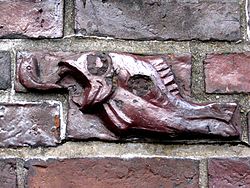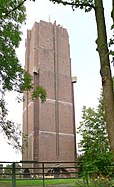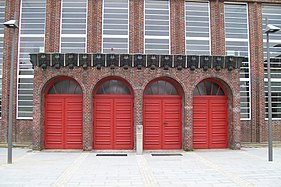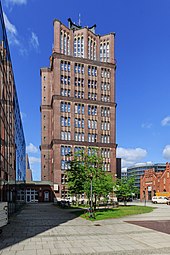Brick expressionism

Brick Expressionism is the name for a special variant of Expressionist architecture using bricks (bricks) or clinker bricks ( clinker expressionism ), which originated mainly in Germany in the 1920s.
Regional centers of Brick Expressionism were the larger cities in northern Germany and the Rhenish-Westphalian industrial area . The Amsterdam School also cultivated the architectural style, which increasingly spread to other regions. Later contemporary architectural trends also repeatedly took up the beginnings of brick expressionism.
style

Brick Expressionism developed parallel to the new, functional architecture of the Bauhaus . While there advocated the abolition of all ornamental forms, the architects of Expressionism developed an ornamental language of forms with rough, angular, often pointed elements. This should express the dynamism of the time, but also its violence and tensions.
The most important building materials were the eponymous brick (brick) and clinker. Hard-burned clinker achieved great popularity, especially for the design of facades. It was best adapted to the difficult climatic conditions of industrial plants, especially in the Ruhr area. But also its characteristic rough surface and the rich color palette from brown to red to purple made it a trend material of this time.
A special feature of brick expressionism is the liveliness of facades, which is achieved solely through the targeted placement of the brick in patterns. This way, large wall surfaces could be enlivened. In some cases, incorrectly burned clinker bricks were even used as decorative elements because of their individual appearance. Architects who had buildings erected in the style of brick expressionism put the angular stones together in many varieties and created a variety of ornamentation and even sculptural design. Horizontal rows of bricks made of alternating set-back and front-facing walls, for example at the Hans-Sachs-Haus in Gelsenkirchen (1927), are another common feature of brick expressionist work.
The facade shapes were complemented by the use of building sculptures made of clinker bricks and ceramics. Richard Kuöhl is a widespread representative . Even Ernst Barlach created statues of clinker bricks, such as the beginning of the frieze communion of saints at the Lübeck St. Catherine's Church (completed by Gerhard Marcks ).
Sometimes there are quotes from other architectural styles that are translated into the language of forms of the brick. So Fritz Högers Chile House in Hamburg from the Art Deco influenced. The Anzeiger high-rise in Hanover quotes oriental architecture. But brick expressionism also produced its own, sometimes idiosyncratic forms such as parabolic churches (such as the Holy Cross Church in Gelsenkirchen-Ückendorf ).
Regional focus
Northern Germany
Some outstanding examples of brick expressionism can be found in Hamburg . Fritz Höger set new standards with the diverse Chilehaus , its strong vertical structure and the almost playful use of the material. Other examples are the neighboring Sprinkenhof complex , the Broschek House , the Leder-Schüler office building and the Haus Neuerburg cigarette factory .
Fritz Schumacher is one of the well-known North German representatives of brick expressionism with numerous public buildings in Hamburg, such as the finance deputation at Gänsemarkt , the crematorium at the Ohlsdorf cemetery , and numerous schools, such as the Walddörfer-Gymnasium in Volksdorf and the school in Jarrestadt.
Many buildings in the style of brick expressionism can also be found in Hanover . In addition to the well-known Anzeiger high-rise by Fritz Höger, a former company building by Hans Poelzig is particularly typical of brick expressionism in Hanover. Numerous new residential buildings were built under the city planning officer and architect Karl Elkart , and in the southern part of the city he realized entire quarters. Elkart also took care of public buildings such as schools, the city library and the workshop building of the Lower Saxony State Theater .
A special example of brick expressionism is Böttcherstraße in Bremen , designed by Bernhard Hoetger. The town hall of Wilhelmshaven was also created by Fritz Höger. The most famous bridges built in the style of brick expressionism are the Cäcilienbrücke and the Amalienbrücke , lift bridges over the coastal canal in Oldenburg (Oldb) . The old Amalienbrücke was demolished in 1980 and replaced by a new construction.
German house in Flensburg, built between 1927 and 1930
Cigarette factory Haus Neuerburg in Hamburg
Entrance building of the Voss margarine factory in Hamburg-Barmbek
Former company building in Hanover designed by Hans Poelzig
Workshops of the Lower Saxony State Theater Hanover and tower of the Hanover City Library
In the Böttcherstrasse in Bremen
Busse monument in Bremerhaven (detail)
Water tower in Hohenkirchen (Wangerland)
Cäcilienbrücke ( lift bridge ) in Oldenburg
Rhenish-Westphalian industrial area
Brick Expressionism was most widespread in the Rhine-Ruhr area and became more or less a regional style. The material withstood the industrial climate. In addition, it made it possible to produce balanced, rich facade designs with comparatively little effort. Only the hard-fired clinker brick was expensive, so that there are also buildings with partly plastered and partly clinker facades.
Both in industrial architecture (factory halls, administration buildings, water towers, etc.) and in residential construction, numerous examples emerged throughout the Ruhr area. Representative buildings such as town halls, post offices, churches and town houses were also built in brick.
An important building from this time is Alfred Fischer's Hans-Sachs-Haus in Gelsenkirchen, which was planned as a multifunctional building but then used as the town hall. With its comparatively simple brick facade and rounded corners, it bridges the gap between expressionism and new objectivity .
Also in Gelsenkirchen, in the Ückendorf district , is the main work of Josef Franke , the parabolic church Heilig-Kreuz . The church vault describes a high parabola. At the top of the angular tower is a brick-built figure of Christ. Holy Cross was closed as a church on August 18, 2007.
Other exemplary buildings in the Ruhr area are the police headquarters, Bert-Brecht-Haus and town hall in Oberhausen , Alfred Fischer's administrative building of the regional association Ruhrgebiet in Essen , the administrative building of BOGESTRA and the police headquarters in Bochum , as well as the children's surgery of the municipal hospital in Dortmund . A specialty of Expressionism can be found in Kamp-Lintfort on the Lower Rhine: Between 1920 and 1924 around 14 semi-detached houses were built there in the Expressionism style, which were built by the coal mine " Friedrich Heinrich " AG for executive employees ("Officials", Steiger). Outstanding examples of brick expressionism in Düsseldorf are the Ehrenhof building ensemble , the Wilhelm-Marx-Haus and the residential buildings on Kaiserswerther Strasse , Uerdinger Strasse ( Rheinpark House ), Cecilienallee , Lützowstrasse and on Golzheimer Platz.
Sparkasse Wanne-Eickel (1926–1928)
Hansa House in Herne (1927/28)
Oberhausen Town Hall (1927–1930)
Main warehouse of the Gutehoffnungshütte by Peter Behrens (1921–1925)
Tonhalle Düsseldorf at the courtyard of Wilhelm Kreis , permanent building for the exhibition GeSoLei (1925/1926)
Prinz-Georg-Strasse 100 , Düsseldorf (1924–1925)
Berlin
- Administration high-rise of the Borsigwerke ( Borsigturm ) in Tegel , design by Eugen Schmohl , built 1922–1925.
- Fernamt Berlin on Winterfeldtstrasse in Schöneberg , design by Otto Spalding and Kurt Kuhlow, created for the Deutsche Reichspost in two construction phases from 1922 to 1929.
- Ullsteinhaus in Tempelhof , designed by Eugen Schmohl , built 1925–1927.
- Service building of the Reichspostzentralamt in Berlin-Tempelhof , Ringbahnstraße 130; Design by Edmund Beisel and Karl Pfuhl , built 1925–1928.
- Kreuzkirche in Schmargendorf , designed by Ernst and Günther Paulus , built 1927–1929.
- House of Radio in Westend , designed by Hans Poelzig , built 1929–1931.
- Church on Hohenzollernplatz in Wilmersdorf , designed in 1928 by Ossip Klarwein in the Fritz Höger office , built 1930–1934.
Silesia
Postal check office in Breslau , designed and supervised by the government builder and later chief post office building officer Lothar Neumann (1891–1963) with ceramic reliefs by Felix Kupsch , built by Huta Hoch- und Tiefbau , 1927–1929 with the first high-rise building in Europe east of Berlin
Other architects (selection)
- Peter Behrens
- Dominikus Böhm (Cologne, Ruhr Area, Swabia, Hesse)
- Karl Elkart (Hanover, Bochum)
- Martin Elsaesser (Southern Germany)
- Alfred Fischer (Essen, Ruhr area)
- Josef Franke (Gelsenkirchen, Ruhr area)
- Walter Frese (Rhineland, Berlin)
- Fritz Höger (Northern Germany and Hamburg, e.g. the Chilehaus )
- Bernhard Hoetger (Böttcherstraße in Bremen and Worpswede)
- Michel de Klerk (Amsterdam)
- Per Kirkeby (Denmark, Germany)
- Edmund Körner (Ruhr area)
- Wilhelm Kreis (Rhineland and Westphalia)
- Max Krusemark (Münsterland, Westphalia)
- Paul Mebes (Berlin, Bochum, Leipzig)
- Hans Heinrich Müller (Berlin)
- Lothar Neumann (Wroclaw)
- Hans Poelzig (Berlin, Breslau)
- Wilhelm Riphahn (Cologne)
- Fritz Schumacher (Hamburg)
- Theodor Veil (Southern Germany and Aachen)
Wulsdorf residential water tower in Bremerhaven
' Het Schip ', apartment building in Amsterdam (1917–1920) by Michel de Klerk , Amsterdam School
See also
literature
- Brick Expressionism , brochure of the city of Gelsenkirchen ( [1] )
- Helmut Bertram: Brick business cards . In: Lichtwark booklet No. 75. HB-Werbung publishing house, Hamburg-Bergedorf 2010. ISSN 1862-3549 .
- Jürgen Kwiatkowski and Peter Gottschlich: Kamp-Lintfort - people and monuments. Sutton-Verlag 2007, ISBN 978-3-86680-092-2 .
- Christoph Rauhut and Niels Lehmann: Fragments of Metropolis: Berlins expressionistisches Erbe Hirmer-Verlag 2015, ISBN 978-3-7774-2290-9 .
- Friedhelm Müller-Düring: The ravages of time are gnawing at the Wilhelmshaven town hall . In: Kulturland Oldenburg. Journal of the Oldenburg landscape . Issue 1/2016, pp. 2–7 ( online )
Web links
Individual evidence
- ^ John Zukowsky (ed.): Architecture in Germany. 1919-1939. The diversity of modernity. Prestel-Verlag, Munich, 1994. ISBN 3-7913-1339-8 . Pp. 157-165.
- ↑ Telecommunications Office 1 monument, 1922–24, 1926–29
- ↑ a b Deutsche Bauzeitung, DBZ, Das Postscheckamt in Breslau, architect Postbauart Lothar Neumann, Breslau , 65th year., 1931, page 61: http://delibra.bg.polsl.pl/Content/13795/no9_10.pdf






































